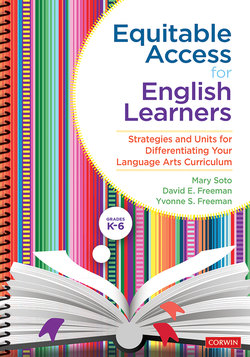Читать книгу Equitable Access for English Learners, Grades K-6 - Mary Soto - Страница 34
На сайте Литреса книга снята с продажи.
Using Formative Assessment
ОглавлениеThe On Demand writing sample is a good example of formative assessment. Formative assessments are designed to help teachers determine students’ current ability in order to plan the next steps in instruction. MacDonald and her colleagues (2015) state that formative assessment “occurs in the midst of instruction and compares students’ ongoing progress to possible trajectories of learning. It can help identify the most productive next steps in instruction” (p. xi). Formative assessment is one component of an overall assessment system that also includes interim and summative assessments.
MacDonald and her coauthors describe a four-stage process they use to integrate formative assessment into teaching. The first step is to design and teach lessons that have a consistent focus on developing both academic content knowledge and academic language. These lessons have clearly stated language objectives. The second step is to sample students’ language by planning lessons during which students will produce language in oral or written form that can be collected. In the third step, teachers analyze student language samples. They use different tools to conduct their analyses and use this information to plan further instruction. The final step is to provide formative feedback. As MacDonald et al. comment, this stage is designed to
give students clear, progress-oriented, and actionable information about their language use—both what they’re doing well and what they can do to become more effective users of English—and to adjust instruction to meet students’ needs. (p. xix)
The four steps form a cycle. The teacher plans instruction, gathers language samples, analyzes the samples, and provides formative feedback.
Teachers who use formative feedback develop different tools to assess language for formative purposes. Three useful tools are checklists, rating scales, and rubrics. Checklists contain items that students or teachers can respond to with a simple “yes” or “no.” For example, with a checklist a student or a teacher could answer questions like “Did I use descriptive adjectives?” or “Did I write complete sentences that start with a capital letter?” Checklists are very useful when students self-assess.
A rating scale moves beyond “yes” and “no” to indicate how well something was done. For example, the teacher or a student could decide whether the writing contained many descriptive adjectives, some descriptive adjectives, or no descriptive adjectives. Similarly, the rating scale could ask if all the sentences were complete, most were complete, or some were complete.
Rubrics are more detailed than rating scales. They outline the criteria students should meet in different areas. Figure 1.9 shows a possible rubric for a short descriptive writing assignment.
Figure 1.9 Writing Rubric
Developing checklists, rating scales, and rubrics helps teachers make their expectations clear to their students, helping students know exactly what they need to do to succeed. These types of assessment can be used by teachers, by students working in pairs or small groups to assess one another’s work, or by individual students.
In many schools, student-led conferences are a type of formative self-assessment used so that students can explain their current work to their parents or guardians. Figure 1.10 shows one young student discussing his work portfolio with his mother.
Figure 1.10 Student-Parent Conference
